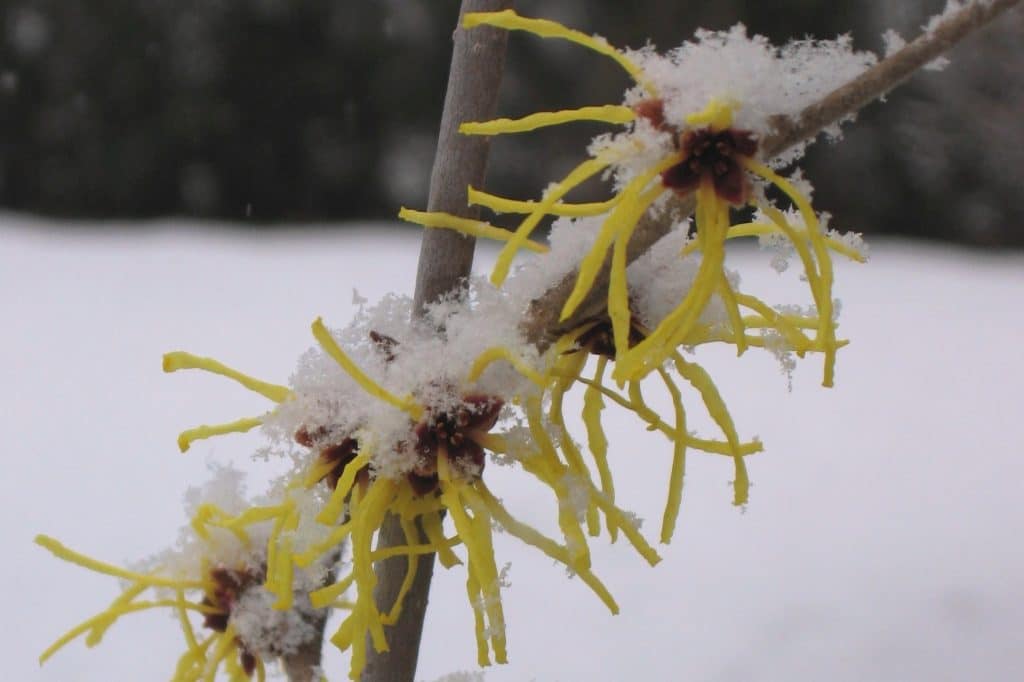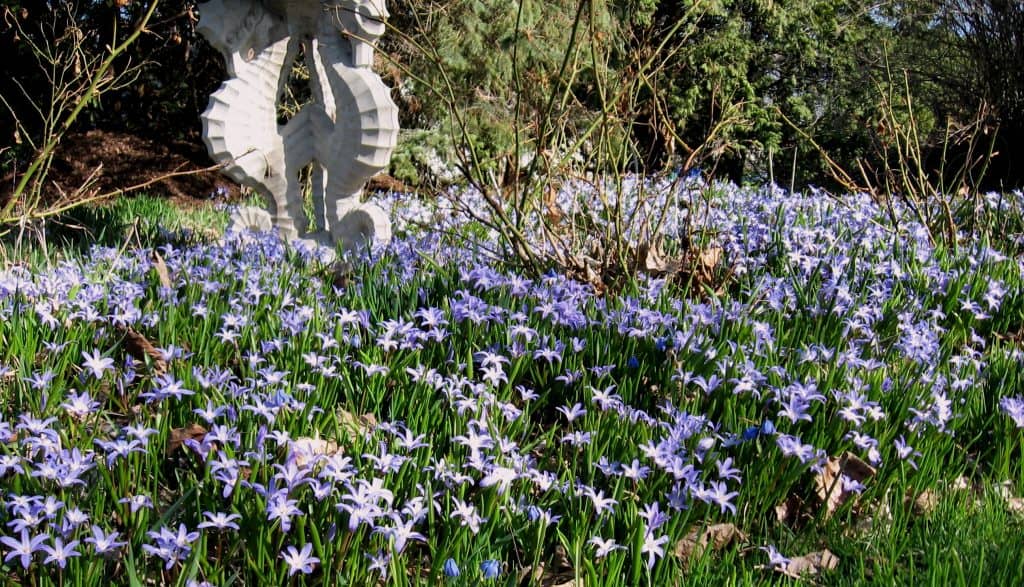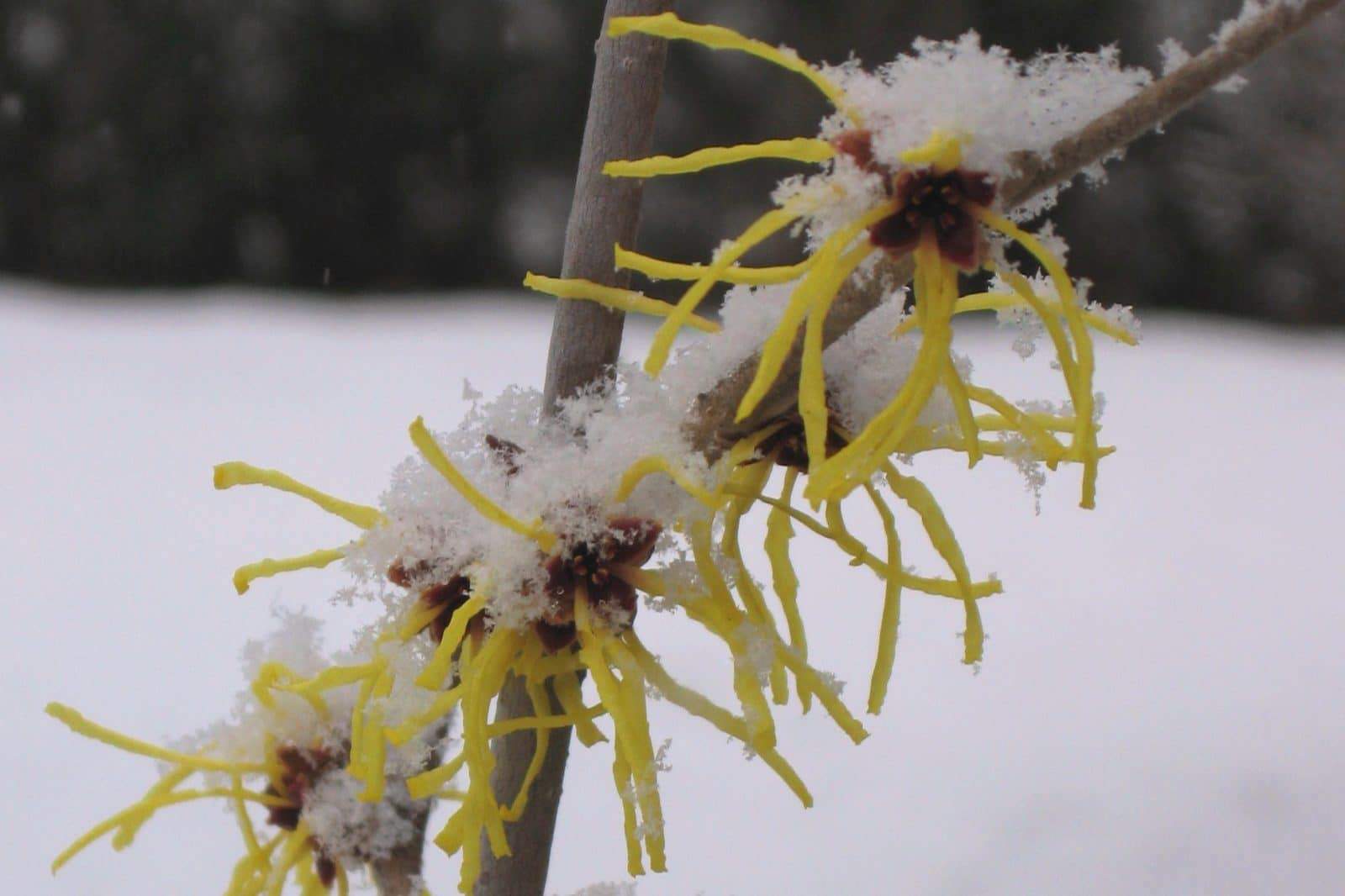
In the warmer parts of Canada spring has already sprung, but in colder regions, it’s still a few weeks away. My own Zone 5 garden in south-central Ontario (about 62 miles/100 km north of Toronto) lies somewhere between the two extremes. The minor bulbs of early spring are in flower, as are the hellebores. Early daffodils are about to pop and magnolia, forsythia and lilac are in heavy bud after a milder than usual winter.
Having gardened in the same spot for 12 years, I have a good idea of what blooms when. But what blooms first in my garden may be entirely different from what flowers first in yours. Much depends on hardiness zones, soil types, rainfall patterns and general topography. Naturally inquisitive, I’m curious about what gardeners in different regions look forward to at this time of year. In other words, which plant’s petals spell spring for you?
My calendar of bloom always begins with hybrid witch-hazels in late winter. The result of crosses between Japanese Hamamelis japonica and Chinese H. mollis, this race of early-blooming shrubs is known botanically as H. ×intermedia. Generally hardy to Zone 5 is the yellow-flowered ‘Pallida’ and copper-red ‘Diane’, two of the hardiest, which I grow. They invariably begin to flower while there’s still snow on the ground, sometime between the end of February and mid-March.
Witch-hazels like to be sited in a full sun to part-shade location (I find an eastern exposure works well) in good garden loam. They’re generally disease and pest free although mildew may be a problem in dry summers; always water plants during droughty periods. Hybrid witch-hazel cultivars are usually grafted onto native H. virginiana rootstock, so be on the lookout for vigorous, upright suckers that may sprout from the (hopefully buried) graft union and prune them out as close to the trunk as possible.
Next on my calendar of bloom come the snowdrops (Galanthus spp. and cvs., Zone 3) and on their heels, several Iris reticulata cultivars (Zone 5), in shades of pale blue (‘Cantab’ and ‘Katharine Hodgkin’) through dark purple (‘J.S. Dijt’). I like to plant snowdrops and early irises together as their brave buds poke up through the retreating snow and flower simultaneously. Hybrid hellebores are the first herbaceous perennials to bloom, and like the early spring bulbs, often find themselves frosted and framed by late season snowfalls.
Next to burst into bloom are the early crocuses (Crocus chrysanthus and C. tommasinianus cvs., Zone 3), which I plant in layers above daffodil bulbs throughout my lawn in generous drifts. As the crocuses fade, the daffodils take over.

Almost coinciding with the early crocuses are luxurious carpets of glory-of-the-snow (Chionodoxa forbesii and C. luciliae, Zone 3) that cover the surface of my rose garden, and have obligingly begun to self-seed in my front lawn. Soon, the daffodils, hyacinths and early tulips will begin to flower along with other minor bulbs like hardy grape hyacinth (Muscari cvs., Zone 4) and Siberian squill (Scilla siberica, Zone 5).
The varied and rapid succession of our fleeting spring blooms can sometimes feel slightly overwhelming — horticulturists call it “the spring glut.” That said, it’s interesting to note that virtually all of our earliest flowers are native to Eurasia. This may not represent an ideal balance, but the bees are undeniably appreciative — we’ve all seen images of ravenous honeybees savaging early crocuses. Early-flowering native species such as hepatica, bloodroot and trillium won’t begin to bloom for several more weeks in my garden.
But regardless of what you grow across this vast and variable country, I’d love to hear which plants produce the first petals in your Canadian garden.



Hi Stephen, Winter aconites bloom well here ,in my garden , in the lawn and moved by seed or squirrels. I live in Simcoe County, zone 5a or maybe 5b at Gilford, just north of Bradford, on some clay and amended soil. Aconite,in March, then squilla in April and now forsthyia and daffodils by May 1. This is not marsh Muck soil but rural village area. This has been written on 2019, May 3rd.
Need any education I can get, as a long time gardener, experience has been my teacher. Bye Lorna Atkins
I live in Edmonton and there is snow in the forecast again tomorrow. 🙁 Usually by now I have scillas all over the place and I love them. My species tulips are next. At this point, my species tulips are well up, but we started a redo on the front yard late last fall and the dirt arrived the same day as the first snow. Of the over 200 bulbs I put in the back yard (because the front wasn’t ready, yet), about 4 are up. So glad to hear that the first year they may be a bit slower, though that probably means they’ll be slow again next year when I get them all moved to where they belong. Nothing in bloom yet this year.
Hi Sharon,
Your comment is a good reminder that spring occurs at different times across the country. So happy to hear that you like species tulips (hint: stay tuned to the blog 😉 ) Fortunately, bulbs are very forgiving, so apart from the legwork, they won’t mind being moved. If possible though, try to wait until their foliage is beginning to yellow (as they enter summer dormancy) before transplanting–that way they’re only semi-conscious when you uproot them. Enjoy your new garden!
Moved from Georgetown, ON to the edge of Algonquin Park six years ago and planted a sea of spring flowering bulbs. So surprised to find the Eranthis hyemalis blooming reliably in the granite rubble earlier than crocus or snowdrops. The Zone 4 winter doesn’t slow them at all and I credit the excellent drainage. (Eremerus sp. also thrives as does Morina longiflora and Eryngium agavifolium, plants that hated the clay of Georgetown!)
Hello Belinda,
I’m beginning to think that I’m the only gardener in central Ontario that can’t grow Eranthis hyemalis (winter aconite). I will have to give it another try, if only to try and save face! And yes, I think you’re right about the excellent drainage, which the Eremurus (foxtail lilies) will also love.
You grow a lot of very interesting and unusual (for Canada) perennials: I remember Morina longifolia (Himalayan whorlflower) from my childhood in Srinagar, Kashmir, but I’ve never seen it here. As a child, I loved that the flowers turned from white to pink after they were pollinated by night-flying moths. And Argentinian Eryngium agavifolium (agave-leaved sea holly) is also not seen often in Canada, but it is a great favourite of famous British gardener, Beth Chatto; I first saw it growing in her Essex (nr. Colchester) garden. Keep pushing those hardiness zones!
I garden in Zone 5A, just north of St. John’s Newfoundland, and the first things to bloom in my garden are crocus and snowdrops, and while i love any burst of colour after our very long winter , my favourite early bloomer is a lovely deep pink Daphne Mezereum, which usually blooms in mid-April. It’s a bit late this year, but the buds are quite plump, just waiting for some sunshine in our sea-view garden. My dark pink Heath heath is just beginning to bloom as well. Lots of early icebergs and our cove is socked in with sea-ice… so no doubt it will be a late Spring…but lots to look forward to..
Hello Mary,
Thank you for mentioning Daphne mezereum (along with Judy, two days ago). One of its common names “February daphne” must make you chuckle. Strangely, where I live in south-central Ontario, it’s hard to find; most nurseries only stock variegated ‘Carol Mackie’, but I don’t think anything can compare to the heady fragrance of “Mezereon.” And your pink heath (Erica carnea) reminds me of England, but sadly, I can’t provide the lean, acidic soil it requires. Lucky you–not to mention your view! We’re so fortunate to have such diverse growing conditions across our great country.
Hi Stephen! The snowdrops are the first to bloom here in my zone 5b southern Ontario garden (near Woodstock) merrily poking out in nice drifts in early March. Incidentally, my grandmother brought these snowdrop bulbs from Germany to my mother in 1976 and they have graced my parents and my sisters’ gardens also.
Right now, the bloodroot is blooming beautifully- their pure white petals are almost blinding in their intensity!
And of course, daffodils in every corner I can plant them! The turkestana tulips are also in bloom, looking very pretty mingling with the blue/pink blooms of lungwort.
Love the ‘spring glut!’
Hi Ela,
I love that your grandmother’s German snowdrops have become a living family heirloom, and are still growing strong 40+ years later! It speaks both to the vigour of the plants and the dedication of the gardeners. And as you say, the almost blindingly white petals of bloodroot are without equal–although the pristine white petals of Madonna lilies (Lilium candidum, Zone 6) run a very close second. Most “white” flowers have a very faint green or blue cast to them, but not these two!
I am in midtown Toronto and my hellebores are just starting to bloom. Why not earlier as others have experienced?
Hi Linda,
If you planted your hellebores last spring or summer, it’s normal for them to bloom a little later in the season than they will in future years, once they’re established (the same is often true for first year bulbs). If they’ve been planted in the same site for several years, it may just be a microclimate issue: Shady spots warm up more slowly than sunny ones, and clay soils remain cold longer than sandy soils. The main thing is that they bloom eventually!
Hi Stephen,
I garden in the Rockies, in Jasper, Alberta. Zone 2-3. The first flowers in my garden are Prairie Crocus (Pulsatilla) – which I like because it reflects what’s blooming out on the south-facing slopes of the river valley. And they feed the early bees!
Soon after the Pulsatilla are Muscari and Scilla. Yes, they are hardier than zone 4-5! and the squirrels leave them alone. I’ve tried species tulips but no matter what I do, they don’t last. Maybe my sandy soil is too tough.
Next are Auricula primroses – tough as nails and long-blooming. Chequered lily (Fritillaria meleagris) also do well here.
My latest experiment is with the new Winter Jewels series Hellebore. I’ve coveted Hellebores forever and with this new series, which is reported to have survived in Winnipeg, I decided to go out on a limb and practice some zone denial! Wish me luck.
Happy growing, everyone.
Hi Tobi,
Pulsatilla (or pasque flower, prairie crocus) is a fantastic plant, but for me it blooms later. I’ve tried several red-flowered cultivars, but only the purple types seem to thrive here. And auriculas are one of my all-time favourites! Where I live, the red lily beetle has decimated my Fritillaria meleagris, so I’ve given up (a particularly horrible beetle). I think you have a good to excellent chance of success with your Winter Jewels Series hellebores; I suspect that they’re hardier than we give them credit for. *Good Luck!*
In my case, it’s always a race as to who blooms first, between snowdrops & winter aconites, usually blooming in mid March. I find the snowdrops prettier, but the winter aconites spread much more vigorously. Then it’s crocuses, glory of the snow, puschkinia & scilla.
Hi Guy,
Thank you for adding Puschkinia scilloides (striped squill) to the list. I had it growing in my last garden, and must get some this autumn to plant in my current plot! Also interested to hear that winter aconite blooms for you in Ottawa–perhaps I should give it another chance here on the shores of Lake Simcoe.
Good morning from the eastern townships – I have had a hamemilis ” Diane” bloom for me for 3 springs now – brought in from Ontario as not considered hardy here. Like you, it is the earliest to bloom followed by snowdrops etc. Probably started to bloom the last week of March but the cover was frozen and snowed into place!
Hello Nancy,
So pleased that you’re enjoying your ‘Diane’ witch hazel. It’s reputed to be hardy to Zone 4, and may well be the hardiest of all the witch hazel hybrids. You might be interested to know that it was introduced in 1969 by Robert de Belder at the Kalmthout Arboretum (Antwerp, Belgium) and named after his daughter. Robert and his equally famous wife Jelena raised many wonderful Hamamelis and Hydrangea cultivars during their lifetimes. If you’re ever lucky enough to find yourself in Belgium, the Kalmthout is well worth a visit!
Hi Stephen,
Happy Spring!
We seem to have our own little microclimate here as the crocus and snowdrops are long done. The little species tulips are blooming as is my February Daphne. I’ve been able to cut some to bring indoors to enjoy. We planted a Cornus Mas last summer and it is just a cloud of yellow blooms now. I’m surprised there are not more of them around. It’s quite a sight when the goldfinches land on it. Just a beautiful riot of colour.
Happy Spring Judy,
And thank you for mentioning Cornus mas (or Cornelian cherry dogwood). As you point out, it’s a fantastic small tree (or multi-stemmed shrub) for early spring bloom, and is sadly under-planted in Canada–particularly as it’s virtually immune to disease and insect pests. Congratulations on the wonderful new addition to your garden from both the goldfinches and me!
After our up and down winter I was surprised to see my yellow witch hazel, H. intermedia blooming out on March 1st a whole month earlier than usual; it is still in full bloom today, mid April. Several varieties of snowdrops, including a very special very double one, came next. I have crocuses, aconites & the carpet of chionodoxas, much admired by passers-by, interspersed now with scillas. My beautiful hellebores, one a dark red have survived a battering with rain and snow recently and my very hardy ‘box store’ yellow primulas are blooming again; they only take a rest between October and March. We shall be moving this year and I do not know which favourites to take and which to leave!
Hi Jennifer,
If I were you, I’d take the hellebores and primulas with you (I did when I moved here–two of only about six species I brought with me). They’re more difficult to replace than the bulbous flowers, with the possible exception of the double snowdrops–they can be hard to find and expensive to replace. I hope your new garden will soon be as beautiful as your current one sounds!
Hi Stephen,
The first blooms in my garden on the Montréal Island are the Winter Aconites ( Eranthis hyemalis). They appear around March 15-20 and last for a full month. I love them!
Hi Sylvain,
So pleased that you mentioned Eranthis hyemalis! I love them too. I had a great patch in my (Zone 6) Toronto garden, but they didn’t do well here in Zone 5, and disappeared after a few years–but a terrific early harbinger of spring–where they’re happy.